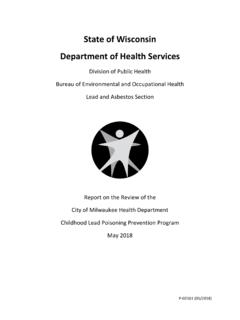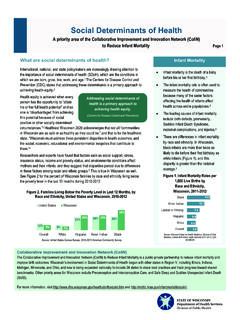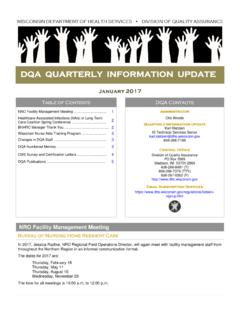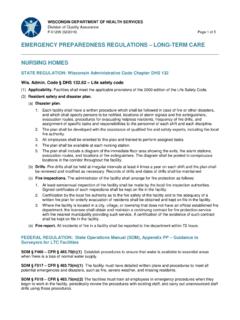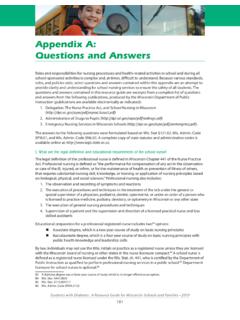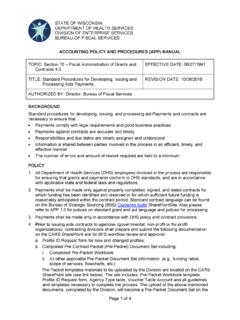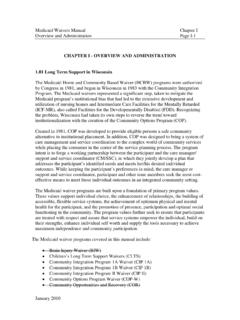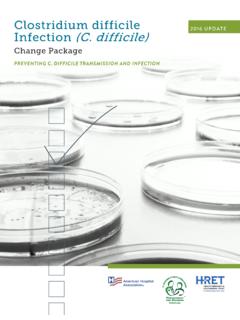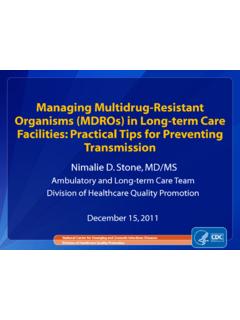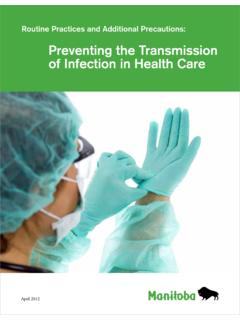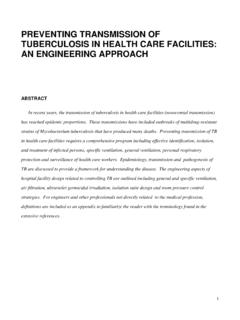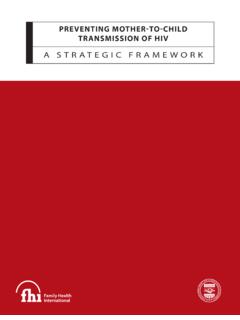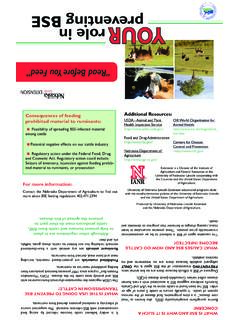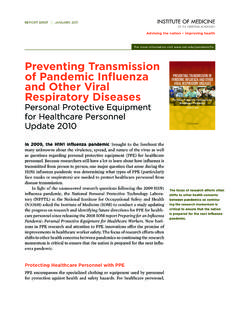Transcription of GUIDANCE FOR PREVENTING TRANSMISSION OF …
1 0 Wisconsin Department of Health Services | Division of Public Health Healthcare-Associated Infections Prevention Program GUIDANCE FOR PREVENTING TRANSMISSION OF carbapenem - resistant enterobacteriaceae (CRE) IN LONG-TERM CARE FACILITIES (LTCF) (05/2018) P-00532 1 GUIDANCE for PREVENTING TRANSMISSION of carbapenem - resistant enterobacteriaceae (CRE) in Long-Term Care Facilities CONTENTS INTRODUCTION AND PURPOSE .. 2 CRE EXPERT PANEL MEMBERS .. 3 UNDERSTANDING CRE AND RISK FACTORS .. 4 TREATMENT AND CDC DEFINITION OF CRE .. 5 CRE PREVENTION .. 6 APPENDIX 1: SAMPLE LTCF CRE POLICY AND PROCEDURE .. 8 APPENDIX 2: INSTRUCTIONS FOR COLLECTION/SUBMISSION OF RECTAL SWABS.
2 11 APPENDIX 3: SAMPLE SCRIPTS FOR EDUCATION .. 13 APPENDIX 4: ALGORITHM FOR NURSING HOME RESPONSE TO CRE .. 15 APPENDIX 5: SAMPLE INTER-FACILITY COMMUNICATIONS FORM .. 16 APPENDIX 6: PREPARING TO RESPOND TO CASES OF CRE .. 17 FREQUENTLY ASKED QUESTIONS .. 18 CRE EDUCATIONAL MATERIALS .. 20 REFERENCES .. 21 2 GUIDANCE for PREVENTING TRANSMISSION of carbapenem - resistant enterobacteriaceae (CRE) in Long-Term Care Facilities INTRODUCTION AND PURPOSE The Wisconsin Division of Public Health (DPH) and the City of Milwaukee Health Department (MHD) initiated a project during 2013 to develop a regional collaborative approach to PREVENTING TRANSMISSION of CRE among health care settings.
3 As part of that project, MHD convened a panel of subject matter experts among acute care hospitals, long-term care hospitals and skilled nursing facilities within its jurisdiction to establish inter-facility communications and consistent CRE prevention practices. This document contains the expert panel recommendations, which are based on the Centers for Disease Control and Prevention s "Facility GUIDANCE for Control of carbapenem - resistant enterobacteriaceae (CRE) November 2015 Update CRE Toolkit. Health care settings covered by these recommendations include long-term care facilities, such as nursing homes, assisted living facilities, and community-based residential facilities.
4 A separate document was developed and updated for acute care and long-term care hospitals. Support for this project was provided in part by a grant to the MHD from the National Association of County and City Health Officials. This document was updated by DPH in April 2018. 3 GUIDANCE for PREVENTING TRANSMISSION of carbapenem - resistant enterobacteriaceae (CRE) in Long-Term Care Facilities CRE EXPERT PANEL MEMBERS Denise Block, RN, BSN, CIC Infection Control Coordinator Wheaton Franciscan St. Joseph, Wisconsin Heart Hospital Midwest Spine & Orthopedic Hospital Gwen Borlaug, MPH, CIC Former HAI Prevention Program Director Wisconsin Division of Public Health Deborah Briggs, RN Infection Preventionist St.
5 Anne s Salvatorian Campus Sandra Coffaro, RN, BSN Communicable Disease Coordinator Disease Control & Prevention Milwaukee Health Department Ashlie Dowdell, BA HAI Surveillance Coordinator Wisconsin Division of Public Health Charles E. Edmiston, Jr., PhD, CIC Professor of Surgery & Hospital Epidemiologist Froedtert & the Medical College of Wisconsin Lina I. Elbadawi, MD, MS LCDR, United States Public Health Service Career Epidemiology Field Officer CDC Bureau of Communicable Diseases Wisconsin Division of Public Health Jessica Frosch, BS MPH Student University of Wisconsin A. Nancy Gagliano, RN, BSN Public Health Nursing Communicable Disease City of Milwaukee Health Department Anna Sarah Kaufman, BS MPH Student University of Wisconsin Heather Kloth, RN, BSN Infection Preventionist, HAI Prevention Program Wisconsin Division of Public Health Gayle Land, RN, BSN, CIC Infection Control Coordinator Wheaton Franciscan St.
6 Joseph Hospital Shannon Lauf, MPH Manager, Communicable Disease & Immunization Milwaukee Health Department Kerri Lintott, RN, CIC Infection Preventionist Aurora Sinai Medical Center Cindy Meyer, RN, BSN Infection Preventionist Luther Manor Senior Living Community Mary Russell, MA Continuing Medical Education Coordinator ProHealth Care Julie Tans-Kersten, MS, BSMT (ASCP) Supervisor, Community and Healthcare Infection Prevention (CHIP) Unit Director, Wisconsin Tuberculosis Program Wisconsin Division of Public Health Nijika Shrivastwa, PhD, MHSA, MPH HAI Prevention Program Director Wisconsin Division of Public Health Angela Tonozzi, MD, MS System Director Infection Prevention Aurora Health Care Patti Wilson, RN, BSN, CIC Infection Preventionist Froedtert Hospital 4 GUIDANCE for PREVENTING TRANSMISSION of carbapenem - resistant enterobacteriaceae (CRE) in Long-Term Care Facilities UNDERSTANDING CRE CRE stands for carbapenem - resistant enterobacteriaceae .
7 enterobacteriaceae are a large family of gram-negative bacilli that are normal inhabitants of the gastrointestinal tract of humans and other animals. enterobacteriaceae can cause infections when they invade the bloodstream, bladder, or other areas of the body. Some CRE have become resistant to all or almost all antibiotics, including last-resort drugs called carbapenems. Three species of the enterobacteriaceae family Klebsiella, Enterobacter, and Escherichia are the most frequently identified CRE in the More than 9,000 healthcare-associated infections are caused by CRE each year. As of February 2018, CDC laboratories have confirmed at least one type of CRE among health care facilities in all 50 states.
8 Approximately 4% of short-stay hospitals and 18% of long-term acute care hospitals reported at least one patient with a serious CRE infection during the first half of 2012. RISK FACTORS Healthy people typically do not acquire CRE infections. CRE infections usually occur among hospitalized patients or residents of long-term care facilities who have underlying medical major risk factors for acquiring CRE infections in the include exposure to health care and treatment with antibiotics such as carbapenems, cephalosporins, fluoroquinolones, and vancomycin. Additional risk factors include a compromised immune system, admission to an intensive care unit, and treatment with invasive devices.
9 Outbreaks of CRE have been associated with exposure to long-term care settings. CRE bacteria are most frequently spread from person to person through contact with infected or colonized individuals. CRE can cause infections when they enter the body, often through medical devices such as intravenous catheters or urinary catheters, or through wounds caused by injury or surgery. Isolation of CRE in a clinical culture can represent either colonization or an infection. Colonization means that the organism is found on or in the body but is not causing symptoms of disease. Colonization with CRE can lead to infection if the organisms gain access to body sites, such as the bladder, lungs, or bloodstream, that are normally sterile.
10 Symptoms of infection vary depending on the site of infection (for example, cough if in the lungs, urinary symptoms if in the bladder) but can also include general symptoms such as fever or chills. Both colonized and infected people can transmit CRE. 5 GUIDANCE for PREVENTING TRANSMISSION of carbapenem - resistant enterobacteriaceae (CRE) in Long-Term Care Facilities TREATMENT OF CRE Though typically resistant to many commonly prescribed antibiotics, CRE may remain susceptible to some antibiotics. Decisions regarding treatment of CRE infections are made on a case-by-case basis by a health care provider. Some people may be colonized rather than infected with CRE and may not require any treatment.

